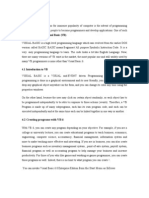Numpy Cheat Sheet Python For Data Science: Inspecting Your Array Sorting Arrays
Uploaded by
Lourdes Victoria UrrutiaNumpy Cheat Sheet Python For Data Science: Inspecting Your Array Sorting Arrays
Uploaded by
Lourdes Victoria Urrutia> Inspecting Your Array > Sorting Arrays
Python For Data Science
>>> a.shape #Array dimensions
>>> a.sort() #Sort an array
>>> len(a) #Length of array
>>> c.sort(axis=0) #Sort the elements of an array's axis
>>> b.ndim #Number of array dimensions
e.size #Number of array elements
NumPy Cheat Sheet
>>>
>>> b.dtype #Data type of array elements
>>>
>>>
b.dtype.name #Name of data type
b.astype(int) #Convert an array to a different type > Subsetting, Slicing, Indexing
Learn NumPy online at www.DataCamp.com Subsetting
> Data Types >>> a[2] #Select the element at the 2nd index
>>> b[1,2] #Select the element at row 1 column 2 (equivalent to b[1][2])
1.5 2
2 3
3
6.0 4 5 6
>>> np.int64 #Signed 64-bit integer types
Slicing
Numpy
>>> np.float32 #Standard double-precision floating point
>>> np.complex #Complex numbers represented by 128 floats
>>> a[0:2] #Select items at index 0 and 1
1 2 3
>>> Numpy
np.bool #Boolean type storing TRUE and FALSE values
array([1, 2])
>>> np.object #Python object type
>>> b[0:2,1] #Select items at rows 0 and 1 in column 1
1.5 2 3
The NumPy library is the core library for scientific computing in Python.
>>> np.string_ #Fixed-length string type
array([ 2., 5.])
4 5 6
>>> np.unicode_ #Fixed-length unicode type >>> b[:1] #Select all items at row 0 (equivalent to b[0:1, :])
It provides a high-performance multidimensional array object, and tools for array([[1.5, 2., 3.]])
1.5 2 3
working with these arrays >>> c[1,...] #Same as [1,:,:]
4 5 6
> Array Mathematics
array([[[ 3., 2., 1.],
Use the following import convention: [ 4., 5., 6.]]])
>>> a[ : :-1] #Reversed array a array([3, 2, 1])
>>> import numpy as np
Boolean Indexing
Arithmetic Operations >>> a[a<2] #Select elements from a less than 2
1 2 3
NumPy Arrays array([1])
>>> g = a - b #Subtraction
Fancy Indexing
array([[-0.5, 0. , 0. ],
>>> b[[1, 0, 1, 0],[0, 1, 2, 0]] #Select elements (1,0),(0,1),(1,2) and (0,0)
[-3. , -3. , -3. ]])
array([ 4. , 2. , 6. , 1.5])
>>> np.subtract(a,b) #Subtraction
>>> b[[1, 0, 1, 0]][:,[0,1,2,0]] #Select a subset of the matrix’s rows and columns
>>> b + a #Addition
array([[ 4. ,5. , 6. , 4. ],
array([[ 2.5, 4. , 6. ],
[ 1.5, 2. , 3. , 1.5],
[ 5. , 7. , 9. ]])
[ 4. , 5. , 6. , 4. ],
>>> np.add(b,a) Addition
[ 1.5, 2. , 3. , 1.5]])
>>> a / b #Division
array([[ 0.66666667, 1. , 1. ],
[ 0.25 , 0.4 , 0.5 ]])
>>> np.divide(a,b) #Division
> Array Manipulation
Creating Arrays
>>> a * b #Multiplication
>
array([[ 1.5, 4. , 9. ],
[ 4. , 10. , 18. ]])
>>> np.multiply(a,b) #Multiplication
Transposing Array
>>> np.exp(b) #Exponentiation
>>> i = np.transpose(b) #Permute array dimensions
>>> a = np.array([1,2,3])
>>> np.sqrt(b) #Square root
>>> i.T #Permute array dimensions
>>> b = np.array([(1.5,2,3), (4,5,6)], dtype = float)
>>> np.sin(a) #Print sines of an array
>>> c = np.array([[(1.5,2,3), (4,5,6)],[(3,2,1), (4,5,6)]], dtype = float) >>> np.cos(b) #Element-wise cosine
Changing Array Shape
>>> np.log(a) #Element-wise natural logarithm
>>> b.ravel() #Flatten the array
>>> e.dot(f) #Dot product
>>> g.reshape(3,-2) #Reshape, but don’t change data
Initial Placeholders array([[ 7., 7.],
[ 7., 7.]]) Adding/Removing Elements
>>> h.resize((2,6)) #Return a new array with shape (2,6)
>>> np.zeros((3,4)) #Create an array of zeros
>>> np.append(h,g) #Append items to an array
>>> np.ones((2,3,4),dtype=np.int16) #Create an array of ones
Comparison >>> np.insert(a, 1, 5) #Insert items in an array
>>> d = np.arange(10,25,5) #Create an array of evenly spaced values (step value)
>>> np.delete(a,[1]) #Delete items from an array
>>> np.linspace(0,2,9) #Create an array of evenly spaced values (number of samples)
>>> e = np.full((2,2),7) #Create a constant array
>>> a == b #Element-wise comparison
Combining Arrays
>>> f = np.eye(2) #Create a 2X2 identity matrix
array([[False, True, True],
>>> np.concatenate((a,d),axis=0) #Concatenate arrays
>>> np.random.random((2,2)) #Create an array with random values
[False, False, False]], dtype=bool)
array([ 1, 2, 3, 10, 15, 20])
>>> np.empty((3,2)) #Create an empty array >>> a < 2 #Element-wise comparison
>>> np.vstack((a,b)) #Stack arrays vertically (row-wise)
array([True, False, False], dtype=bool)
array([[ 1. , 2. , 3. ],
>>> np.array_equal(a, b) #Array-wise comparison [ 1.5, 2. , 3. ],
[ 4. , 5. , 6. ]])
> I/O Aggregate Functions
>>> np.r_[e,f] #Stack arrays vertically (row-wise)
>>> np.hstack((e,f)) #Stack arrays horizontally (column-wise)
array([[ 7., 7., 1., 0.],
[ 7., 7., 0., 1.]])
Saving & Loading On Disk >>> a.sum() #Array-wise sum
>>> np.column_stack((a,d)) #Create stacked column-wise arrays
>>> a.min() #Array-wise minimum value
array([[ 1, 10],
>>> b.max(axis=0) #Maximum value of an array row
[ 2, 15],
>>> np.save('my_array', a)
>>> b.cumsum(axis=1) #Cumulative sum of the elements
[ 3, 20]])
>>> np.savez('array.npz', a, b)
>>> a.mean() #Mean
>>> np.c_[a,d] #Create stacked column-wise arrays
>>> np.load('my_array.npy') >>> b.median() #Median
>>> a.corrcoef() #Correlation coefficient
Splitting Arrays
>>> np.std(b) #Standard deviation >>> np.hsplit(a,3) #Split the array horizontally at the 3rd index
Saving & Loading Text Files [array([1]),array([2]),array([3])]
>>> np.vsplit(c,2) #Split the array vertically at the 2nd index
>>> np.loadtxt("myfile.txt")
>>> np.genfromtxt("my_file.csv", delimiter=',')
>>> np.savetxt("myarray.txt", a, delimiter=" ")
> Copying Arrays [array([[[ 1.5, 2. , 1. ],
[ 4. , 5. , 6. ]]]),
array([[[ 3., 2., 3.],
[ 4., 5., 6.]]])]
>>> h = a.view() #Create a view of the array with the same data
>>> np.copy(a) #Create a copy of the array
>>> h = a.copy() #Create a deep copy of the array
> Asking For Help
Learn Data Skills Online at www.DataCamp.com
>>> np.info(np.ndarray.dtype)
You might also like
- Lingua Latina Per Se Illustrat - Ørberg, Hans H._8297100% (1)Lingua Latina Per Se Illustrat - Ørberg, Hans H._8297429 pages
- PASCAL Plus Data Structures, Algorithms, and Advanced Programming PDF50% (2)PASCAL Plus Data Structures, Algorithms, and Advanced Programming PDF657 pages
- Solving Systems of Equations With Matrices On The Ti PDFNo ratings yetSolving Systems of Equations With Matrices On The Ti PDF2 pages
- Find All Students With Gpa 3.0'': Can Do Binary Search On (Smaller) Index File!No ratings yetFind All Students With Gpa 3.0'': Can Do Binary Search On (Smaller) Index File!42 pages
- Python3 Data Structures Cheat Sheet: by ViaNo ratings yetPython3 Data Structures Cheat Sheet: by Via1 page
- Introductory Concepts of Probabability & StatisticsNo ratings yetIntroductory Concepts of Probabability & Statistics6 pages
- Beginners Python Cheat Sheet PCC Files Exceptions PDFNo ratings yetBeginners Python Cheat Sheet PCC Files Exceptions PDF2 pages
- Crear: Crud/Abm Practica NOMBRE: Assad Joaquin Cadena AntonioNo ratings yetCrear: Crud/Abm Practica NOMBRE: Assad Joaquin Cadena Antonio7 pages
- APA Citation: - In-Text Citation - Reference Page - Paraphrasing and SummarizingNo ratings yetAPA Citation: - In-Text Citation - Reference Page - Paraphrasing and Summarizing19 pages
- Object Oriented Programming Using Python: Name:Ankeet Giri Reg No.: 11904096No ratings yetObject Oriented Programming Using Python: Name:Ankeet Giri Reg No.: 1190409620 pages
- Python Tricks That You Can't Live Without - Audrey RoyNo ratings yetPython Tricks That You Can't Live Without - Audrey Roy45 pages
- The Age of Analytics - Competing in A Data-Driven World - McKinsey & CompanyNo ratings yetThe Age of Analytics - Competing in A Data-Driven World - McKinsey & Company6 pages
- Scientific WorkPlace Demonstration Document100% (1)Scientific WorkPlace Demonstration Document31 pages
- Fisiología Veterinaria 4ta - Cunningham PDFNo ratings yetFisiología Veterinaria 4ta - Cunningham PDF718 pages
- SAS Job Execution Web Application 2.1 - User S GuideNo ratings yetSAS Job Execution Web Application 2.1 - User S Guide94 pages
- Boolean Algebra: Name Reads As Logic Gate OCR Notation Alternative Notation Examples Truth Table NotesNo ratings yetBoolean Algebra: Name Reads As Logic Gate OCR Notation Alternative Notation Examples Truth Table Notes2 pages
- Containerized Docker Application Lifecycle With Microsoft Platform and Tools0% (1)Containerized Docker Application Lifecycle With Microsoft Platform and Tools103 pages
- A 18-Page Statistics & Data Science Cheat SheetsNo ratings yetA 18-Page Statistics & Data Science Cheat Sheets18 pages
- Deployment: Cheat Sheet: Machine Learning With KNIME Analytics PlatformNo ratings yetDeployment: Cheat Sheet: Machine Learning With KNIME Analytics Platform1 page
- Scipy Cheat Sheet Python For Data Science: Linear AlgebraNo ratings yetScipy Cheat Sheet Python For Data Science: Linear Algebra1 page
- STAT 0202 Outlier Syllabus - Spring 2020 - Regular Term (14-Wk) - 12-2No ratings yetSTAT 0202 Outlier Syllabus - Spring 2020 - Regular Term (14-Wk) - 12-27 pages
- Scikit-Learn Cheat Sheet Python For Data Science: Preprocessing The Data Evaluate Your Model's Performance100% (1)Scikit-Learn Cheat Sheet Python For Data Science: Preprocessing The Data Evaluate Your Model's Performance1 page
- Bachelor of Technology in Department of Information Technology & EngineeringNo ratings yetBachelor of Technology in Department of Information Technology & Engineering51 pages
- Driver For TCP-IP Communication With Devices Using Modbus ProtocolNo ratings yetDriver For TCP-IP Communication With Devices Using Modbus Protocol24 pages
- Numerical Methods Using Python: (MCSC-202)No ratings yetNumerical Methods Using Python: (MCSC-202)29 pages
- JavaScript Fundamentals - Little Green Apples Publishing PDFNo ratings yetJavaScript Fundamentals - Little Green Apples Publishing PDF39 pages
- Java Intermediate: Pervasive Shallowness in Java0% (1)Java Intermediate: Pervasive Shallowness in Java13 pages
- JEDI Slides-Intro1-Chapter04-Programming FundamentalsNo ratings yetJEDI Slides-Intro1-Chapter04-Programming Fundamentals96 pages
- Database Systems and Applications Applications: Bits, Pilani - K. K. Birla Goa CampusNo ratings yetDatabase Systems and Applications Applications: Bits, Pilani - K. K. Birla Goa Campus10 pages






























































































